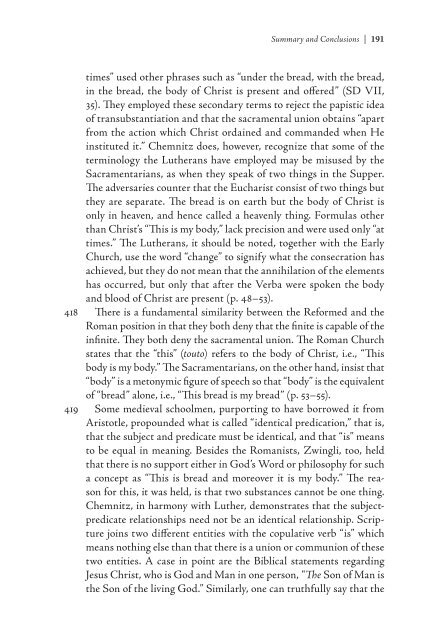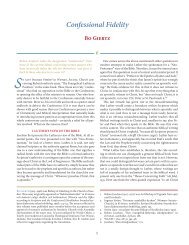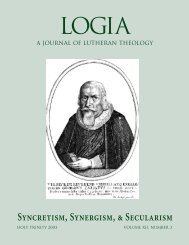The Lord's Supper in the Theology of Martin Chemnitz Bjarne - Logia
The Lord's Supper in the Theology of Martin Chemnitz Bjarne - Logia
The Lord's Supper in the Theology of Martin Chemnitz Bjarne - Logia
You also want an ePaper? Increase the reach of your titles
YUMPU automatically turns print PDFs into web optimized ePapers that Google loves.
Summary and Conclusions |<br />
times” used o<strong>the</strong>r phrases such as “under <strong>the</strong> bread, with <strong>the</strong> bread,<br />
<strong>in</strong> <strong>the</strong> bread, <strong>the</strong> body <strong>of</strong> Christ is present and <strong>of</strong>fered” (SD VII,<br />
35). <strong>The</strong>y employed <strong>the</strong>se secondary terms to reject <strong>the</strong> papistic idea<br />
<strong>of</strong> transubstantiation and that <strong>the</strong> sacramental union obta<strong>in</strong>s “apart<br />
from <strong>the</strong> action which Christ orda<strong>in</strong>ed and commanded when He<br />
<strong>in</strong>stituted it.” <strong>Chemnitz</strong> does, however, recognize that some <strong>of</strong> <strong>the</strong><br />
term<strong>in</strong>ology <strong>the</strong> Lu<strong>the</strong>rans have employed may be misused by <strong>the</strong><br />
Sacramentarians, as when <strong>the</strong>y speak <strong>of</strong> two th<strong>in</strong>gs <strong>in</strong> <strong>the</strong> <strong>Supper</strong>.<br />
<strong>The</strong> adversaries counter that <strong>the</strong> Eucharist consist <strong>of</strong> two th<strong>in</strong>gs but<br />
<strong>the</strong>y are separate. <strong>The</strong> bread is on earth but <strong>the</strong> body <strong>of</strong> Christ is<br />
only <strong>in</strong> heaven, and hence called a heavenly th<strong>in</strong>g. Formulas o<strong>the</strong>r<br />
than Christ’s “This is my body,” lack precision and were used only “at<br />
times.” <strong>The</strong> Lu<strong>the</strong>rans, it should be noted, toge<strong>the</strong>r with <strong>the</strong> Early<br />
Church, use <strong>the</strong> word “change” to signify what <strong>the</strong> consecration has<br />
achieved, but <strong>the</strong>y do not mean that <strong>the</strong> annihilation <strong>of</strong> <strong>the</strong> elements<br />
has occurred, but only that after <strong>the</strong> Verba were spoken <strong>the</strong> body<br />
and blood <strong>of</strong> Christ are present (p. 48–53).<br />
418 <strong>The</strong>re is a fundamental similarity between <strong>the</strong> Reformed and <strong>the</strong><br />
Roman position <strong>in</strong> that <strong>the</strong>y both deny that <strong>the</strong> f<strong>in</strong>ite is capable <strong>of</strong> <strong>the</strong><br />
<strong>in</strong>f<strong>in</strong>ite. <strong>The</strong>y both deny <strong>the</strong> sacramental union. <strong>The</strong> Roman Church<br />
states that <strong>the</strong> “this” (touto) refers to <strong>the</strong> body <strong>of</strong> Christ, i.e., “This<br />
body is my body.” <strong>The</strong> Sacramentarians, on <strong>the</strong> o<strong>the</strong>r hand, <strong>in</strong>sist that<br />
“body” is a metonymic figure <strong>of</strong> speech so that “body” is <strong>the</strong> equivalent<br />
<strong>of</strong> “bread” alone, i.e., “This bread is my bread” (p. 53–55).<br />
419 Some medieval schoolmen, purport<strong>in</strong>g to have borrowed it from<br />
Aristotle, propounded what is called “identical predication,” that is,<br />
that <strong>the</strong> subject and predicate must be identical, and that “is” means<br />
to be equal <strong>in</strong> mean<strong>in</strong>g. Besides <strong>the</strong> Romanists, Zw<strong>in</strong>gli, too, held<br />
that <strong>the</strong>re is no support ei<strong>the</strong>r <strong>in</strong> God’s Word or philosophy for such<br />
a concept as “This is bread and moreover it is my body.” <strong>The</strong> reason<br />
for this, it was held, is that two substances cannot be one th<strong>in</strong>g.<br />
<strong>Chemnitz</strong>, <strong>in</strong> harmony with Lu<strong>the</strong>r, demonstrates that <strong>the</strong> subjectpredicate<br />
relationships need not be an identical relationship. Scripture<br />
jo<strong>in</strong>s two different entities with <strong>the</strong> copulative verb “is” which<br />
means noth<strong>in</strong>g else than that <strong>the</strong>re is a union or communion <strong>of</strong> <strong>the</strong>se<br />
two entities. A case <strong>in</strong> po<strong>in</strong>t are <strong>the</strong> Biblical statements regard<strong>in</strong>g<br />
Jesus Christ, who is God and Man <strong>in</strong> one person, “<strong>The</strong> Son <strong>of</strong> Man is<br />
<strong>the</strong> Son <strong>of</strong> <strong>the</strong> liv<strong>in</strong>g God.” Similarly, one can truthfully say that <strong>the</strong>




